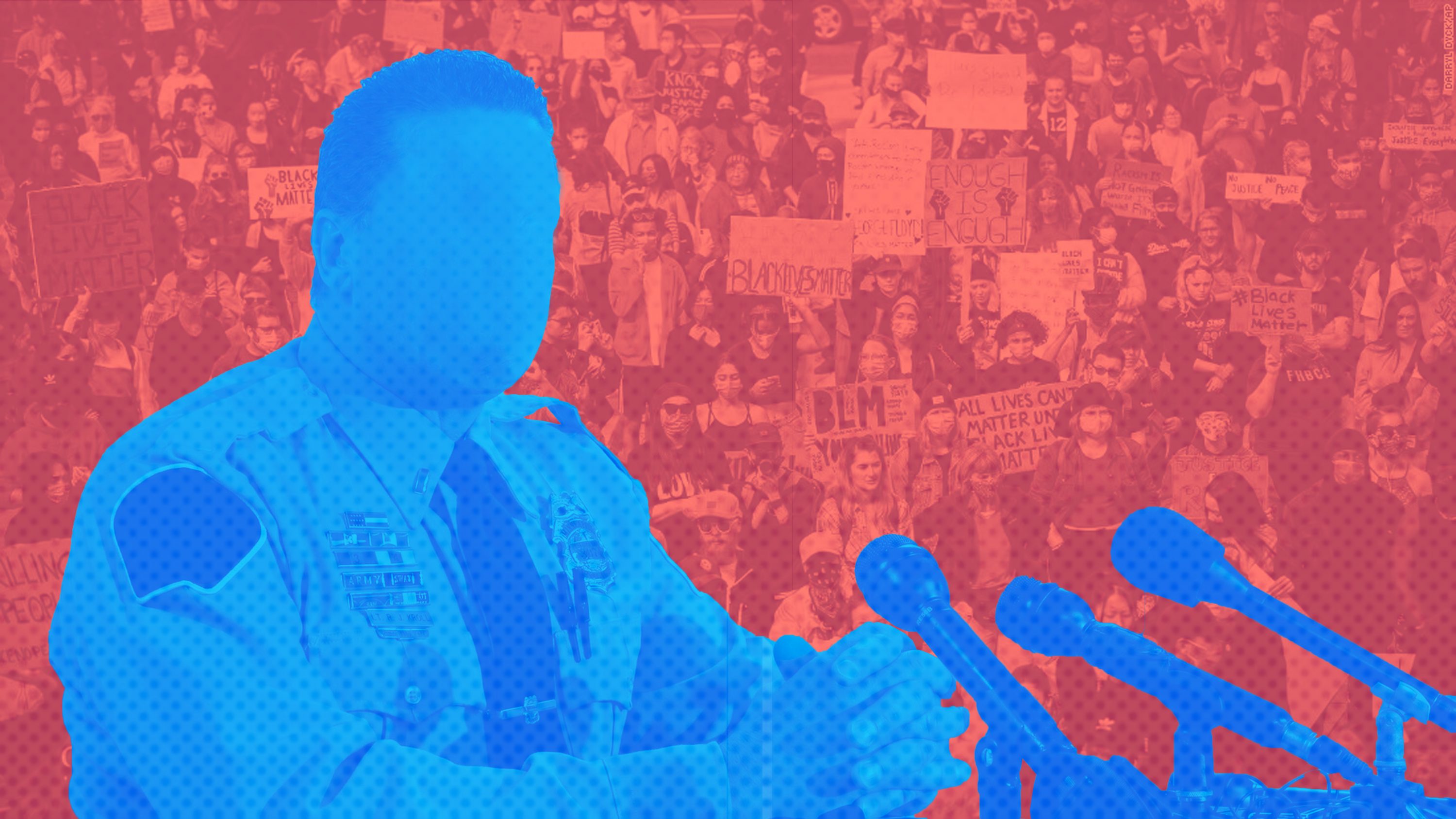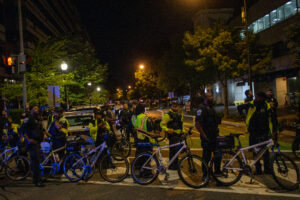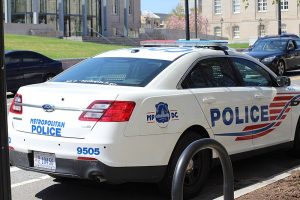Content warning: This article discusses racism, police violence, and death.
The officers who murdered Breonna Taylor on March 13 have still not been arrested. No charges were filed against the officer who killed Eric Garner. A grand jury chose not to indict the officer who killed Michael Brown in 2014. The officer who knelt on the neck of George Floyd was arrested four days after the murder, which is comparatively quick in the history of prosecution for police brutality against Black Americans.
Throughout the Black Lives Matter protests, protesters have called for widespread institutional change to the criminal justice system and operations of police departments across the nation. But change has not come quickly, nor easily.
One of the main blockades to law enforcement reform: police unions.
Police unions negotiate with cities over pay and the protection of their officers. Though police unions were banned until 1838 due to concerns about armed government agents organizing, today they act as one of the most powerful lobbying groups in the nation.
Police unions allow departments to strong-arm negotiations with city governments and steamroll legislative policies with unchecked lobbying. And they protect their own repeatedly.
Between 900 to 1,000 people are shot and killed by police in the United States every year. Since 2005, 98 nonfederal officers have been arrested for on-duty shootings; as of 2019, only 35 have been convicted. Those convicted are rarely found guilty of murder, but of lesser indictments like manslaughter, which carry lighter sentences.
Black and Hispanic individuals bear the biggest brunt of police killings—disproportionately so. Black Americans make up less than 13 percent of the U.S. population, but are killed by police at double the rate of white Americans. Moreover, deaths of Latinx and Native American individuals are systemically underreported when people are placed under the ‘white,’ ‘black,’ or ‘other’ category. Even with inaccurate reporting, these communities are disproportionately killed in police shootings.
Before he knelt on Floyd’s neck, Officer Derek Chauvin was the subject of 18 complaints in his 19 years in the police force. He was reprimanded twice—both times for incidents involving shooting civilians. Chauvin has shot three people in his time on the force, killing one. Police unions use their negotiating power to appeal judicial rulings and city policies that would see officers like Chauvin reprimanded, fired, or arrested. Under the Minneapolis Police Departments collective bargaining contract, any disciplinary records that did not result in punishment must be removed from an officer’s file. Officers who are fired for misconduct are still entitled to an appeals process that often results in reinstatement.
There are real, violent implications to the barriers they raise: a 2018 study by the University of Oxford found a direct positive correlation between police violence and misconduct in U.S. cities and the “robustness of protections afforded to police through union mechanisms.” A 2019 study by the University of Chicago discovered a 40 percent increase in cases of police violence in Florida following an expansion of collective-bargaining rights to police departments.
Calling for the arrest and proper punishment of individual officers after every incident of brutality is an exhausting process that will only lead to temporary justice. The reform and eventual dismantling of national police unions is the only way to remove major barriers to the institutional change policing in America requires.
According to Christine Lopez, a professor at Georgetown Law School and the leader of the Department of Justice investigation of the Ferguson Police Department commissioned by President Barack Obama, police unions across the nation bargain for excessive protections for officers accused of misconduct. While most labor unions negotiate benefits that benefit its entire membership, such as a pay raise or healthcare provisions, police unions often forgo monetary benefits as a bargaining chip to protect officers involved in disciplinary proceedings.
“For example, they will say ‘no, that’s fine. You don’t need to give us the five percent wage increase we initially asked for, just make sure you give us the opportunity to not have to be interviewed for 48 hours after a critical incident happens,’” Lopez said.
Unions can also negotiate for cities to remove complaints from personnel files after one year. At the time union contracts are negotiated, Lopez explained, the opportunity to save on pay raises in exchange for unpublished complaints is an attractive deal for the city. “It only comes back to bite you if and when you get sued,” she said.
The long term cost of such a deal, however, is transparency. And more deaths of innocent Americans.
Allowing police departments to remove or conceal misconduct records makes it challenging for officials to discover patterns of harmful employee history or handle so-called “bad apples.” Many officers who are tried for police brutality have long histories of violence filed away from public view—so when their use of force results in civilian death, it seems inexcusable they were not disciplined long before.
The problem to Lopez is not collective bargaining itself, but rather the outsized acquiescences cities make to police unions.
“I do think there’s a need for workers to sort of use their collective strength to ensure that their rights are being respected and they get the best deal they can from their employers,” she said.
Greggory Pemberton, the chairman of the D.C. Police Union, which represents 3,600 members of the Metropolitan Police Department (MPD), also defends the role of police unions in protecting employees. He argues that, like unions for teachers or firefighters, collective bargaining ultimately protects workers from unfair treatment or discrimination.
“Unions make sure that the disciplinary system is actually carried out with some fairness and some integrity,” Pemberton said. “So if there’s an allegation against them, it has to be investigated. That investigation has to be based on facts and merit.”
Pemberton maintains police unions ensure equality and prevent racist or sexist treatment within the force, as an officer can only be fired for just cause. According to Pemberton, the union protects minority officers from discrimination or over-disciplining.
Lopez and Pemberton are right. Every body of workers should be able to advocate for employee rights, and protections should exist within police departments to prevent the unfair termination of workers based on gender, race, sexuality, ethnicity, or religion.
But police unions and teachers unions are not analogous. Teachers do not have the legal ability to kill as a part of their job. Some teachers may deserve judicial proceedings for misconduct, yet numbers of teachers with formal complaints pale in comparison to the incidents of violence initiated by police officers each year.
Teachers, janitors, and truck drivers unionizing to ensure fair compensation and conditions is one thing. Using the power of a union to intimidate politicians and torment communities of color is another.
Police unions across the U.S. spend millions of dollars lobbying for politicians who pledge to fund police departments. Unlike their equivalents in Canada and the U.K., American police unions are not impeded from endorsing candidates and donating to campaigns. According to Maplight data, police unions have spent at least $47.3 million in federal elections since the 2008 cycle, and leverage substantial influence in local elections. These dollars often go towards politicians considered “tough on crime” who dismiss calls to reform police or reduce department funding.
Pemberton defended police unions in these scenarios, claiming that their purpose was to prevent the very increases in misconduct they seem to allow.
“Nobody hates bad cops more than police unions. Set aside for a moment, just the ethical and integrity issues that come with working next to somebody that is doing their job in a malicious manner,” he said. “It does not help police unions, to advocate for bad cops, it doesn’t help our ability to collect a bargain. It doesn’t help our public relations.”
Following a complaint, police unions provide members with an attorney to ensure a fair trial and that minority officers are not unfairly terminated, according to Pemberton. The case is heard before a panel to determine if the officer can keep their job. Even if the panel agreed that the officer should be terminated, the union can still appeal the decision to an arbitrator to settle the dispute. While police unions may hate bad cops nominally, they still protect them through the system of defense they have created.
Everyday citizens rely on the justice system as it is to make judgements, yet police unions go beyond basic legal protection of their employees—they retain additional defenses and loopholes for self-preservation. These same defenses are not afforded to civilians subject to police brutality and a flawed criminal justice system. Our current judicial system needs reform, but as long as everyday Americans go through it, our police should too.
Police violence in 2020 has included not only the direct murders of Taylor, Floyd, Tony McDade, and David McAtee, but widespread violence against protesters participating in marches across the country. Reports from Portland tell of protesters beaten unconscious in the street, and in New York, officers drove a police vehicle into a Brooklyn crowd, knocking protesters to the ground.
On July 22 of this year, D.C. Mayor Bowser signed emergency legislation prohibiting D.C. police from using pepper spray, tear gas, stun grenades, or rubber bullets against a crowd of protesters. The reform bill also required the swifter release of body camera footage and the reduced role of police unions in officer disciplinary proceedings.
According to Pemberton, the new reforms do little to restrict officers’ use of force—while the bill forbids the use of rubber bullets, pepper spray, stun grenades, and tear gas at First Amendment assemblies, officers were already forbidden from doing so under Title 22 in D.C. code. According to Pemberton, once a protest results in $5,000 of damage, the protest is classified as a “riot” and police can use previously restricted force.
The concept that police force can be turned on or off at the arbitrary and subjective line of $5,000 in damage is concerning. Any area of arbitrary legal policy disadvantages the public and benefits police unions who can use uncertainty to settle disputes in favor of their members.
The only way to end the terror of police brutality is to pursue more radical forms of reform, such as reducing the authority and of departments and their contact with communities, but police unions remain the loudest critic of even minor improvements.
A June 25 decision by D.C.’s Committee on the Judiciary and Public Safety approved a $15 million cut from the MPD budget. Pemberton protested proposed funding cuts to the MPD, arguing budget cuts might result in a reduction of 264 officers in the next year.
“That’s an entire police district when you’re talking about,” Pemberton said. “That is really going to affect our ability to service communities at the rate that we would like.”
However, many protesters advocate for a “divest and invest” model, using funds typically earmarked for police departments for alternate programs would also serve the community and address mental illness, domestic violence, or neighborhood disagreements that do not require police presence.
Alternative programs to policing have been growing across the country with success, such as Crisis Assistance Helping Out On The Streets (CAHOOTS) based out of Eugene, Oregon. A mental health intervention organization that aims to remove police from mental health-related 911 situations, the program estimates it can handle 17 percent of public safety calls, reducing contact between the police and individuals with mental illnesses. Considering that 22 percent of violent deaths by police are related to mental illness, organizations like CAHOOTS can help prevent unnecessary murders.
Reducing contact between police and communities in exchange for alternative systems of public safety support will also help reduce over-policing people of color. America’s imprisonment rate is the highest in the world, with Black individuals incarcerated at a rate over five percent greater than that of white individuals.
While police departments have their place in regards to violent crime, their authority has grown and with it, the excess use of force. The 911 call that led to Floyd’s death was about a potentially counterfeit bill—a minor offense, if an offense at all. Police were not necessary in the first place, and an alternate facilitator could have resolved the situation without violence. Instead, Floyd, an unarmed civilian, was murdered.
Pemberton believes that alternative policing won’t reduce police workload to the extent advocates believe, leaving departments stretched thin, an argument commonly offered by police advocates.
“Other community services, they might be better at handling some of the things, but you can’t tell me that police officers are going to have less work to do on any given day,” he said. “The problem is generally when you reduce police budgets in the first place, as the money comes out of manpower and training.”
Pemberton argued that the police have been taking on the responsibilities of alternative organizations that aimed to handle mental illness and domestic abuse calls for years, placing more burden on officers.
“The original agencies that were designed to do this have failed,” he said.
Addressing rebuttals by police unions toward reform policies, Lopez advised questioning past arguments by the police unions that have granted them their power at the expense of other civilians.
“We have to be really skeptical when anyone comes back and says, ‘Well you know, you’re going to risk the lives of officers, the tear-gassing works, what was the behavior of the protesters,’” Lopez said. “We have to ask ourselves, is this a meaningfully protective measure, or is it just something that has been abused? You have to look at the evidence and the facts.”
While Pemberton articulated the union’s arguments against aggressive police reform, past incremental legislation has failed to reduce police brutality in this country. There is no perfect solution—but with every death at the hands of police comes the necessity for radical reform to policing in America.
Far too many Black Americans have died at the hands of police. The ability of the police force as a whole to surveil and target communities of color will continue to cost the lives of Black Americans.
Body cameras have resulted in no statistical change in police behavior or increased termination for officers who use excessive force. Increased training did not prevent the deaths of Eric Garner, Freddie Gray, or Philando Castile. The only way to reduce police violence in America is to limit the interaction between police and public. Reduction of the police itself, long feared due to violent and often racist conceptions of police power, is the sole method that can end the patterns of prejudice that continue to cost lives today.
Alternative policing programs can, and do, work. In the meantime, as broader reforms are sought, police unions must first be dismantled. So long as police unions—and the problematic, deadly barriers they erect—exist, officers will continue not to face real accountability for acts of violence. Reform is possible. We just have to be brave enough to pursue it.




